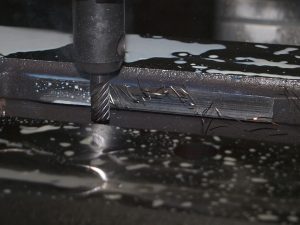
Milling is a common machining process that involves the use of a machine, known as a milling machine, to remove material from a stationary workpiece using a rotating cutting tool. With milling, the workpiece remains stationary, whereas the cutting tool rotates. As the rotating cutting tool presses against the workpiece, it removes material.
While all milling machines follow this same basic formula, there are different types of milling machines, each of which has its own unique characteristics. In this post, we’re going to explore the differences between horizontal milling machines and vertical milling machines.
What Is a Vertical Milling Machine?
The most common type of milling machine, a vertical milling machine features a vertically oriented spindle that holds, as well as rotates, the cutting tool against the stationary workpiece. The spindle is capable of moving up and down — all while pressing against the workpiece to remove material.
There are actually two distinct types of vertical milling machines: turret milling machines and bed milling machines. In a turret milling machine, the spindle and table can move perpendicular and parallel to the axis. In comparison, bed milling machines only move the table perpendicular to the axis. Many manufacturing companies prefer turret milling machines because of their versatility. They are able to perform a wider range of milling operations than bed milling machines, making them a smart investment for manufacturing companies.
What Is a Horizontal Milling Machine?
Horizontal milling machines feature a similar design in which a spindle containing a rotating cutting tool presses against a workpiece to remove material from the workpiece. With that said, horizontal milling machines differ from their vertical counterparts in several ways. The biggest difference between these two types of milling machines is the orientation of the spindle. With vertical milling machines, the spindle features a vertical orientation. With horizontal milling machines, the spindle features a horizontal orientation. In other words, horizontal milling machines mount the cutting tool on a horizontally oriented spindle that’s able to selectively remove material from the stationary workpiece.
Furthermore, horizontal milling machines usually feature different cutting tools than vertical milling machines. While vertical milling machines usually have long and thin cutting tools, horizontal milling machines have shorter and thicker cutting tools.
Horizontal milling machines are able to perform heavier, deeper cuts than vertical milling machines. As a result, manufacturing companies often use them to cut grooves or slots into workpieces. Hopefully, this gives you a better understanding of the differences between vertical milling machines and horizontal milling machines.
